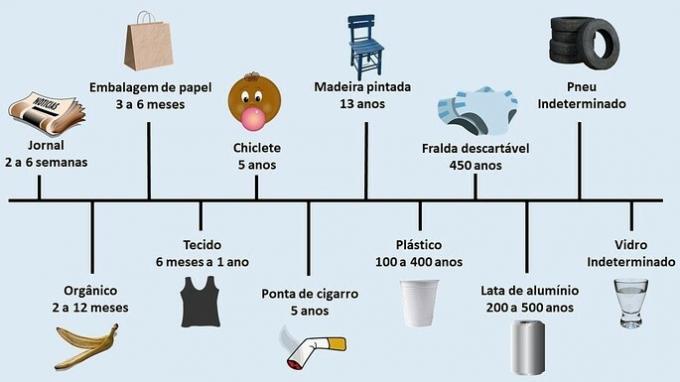The biotic and abiotic factors represent the existing relationships that allow the ecosystem to balance.
Biotic factors correspond to living communities in an ecosystem, which can be either a forest or a small aquarium. Examples are: plants, animals, fungi and bacteria.
Abiotic factors, on the other hand, are the physical, chemical or geological elements of the environment, responsible for determining, on a large scale, the structure and functioning of these communities. Examples are: water, soil, air and heat.

Through the image, we see some examples of biotic and abiotic factors. Are they:
Biotic Factors: producing beings (plants and algae), consuming beings (herbivores and carnivores) and decomposing beings (fungi and bacteria).
abiotic factors: water, light (light energy), heat (thermal energy) and nutrients (chemicals).
What are biotic factors?
Biotic factors are the result of the interaction between living beings in a given region. Together, they form the biota, that is, the biological community that influences the ecosystem of which they are a part.
For example, in a mangrove, all animal and plant species make up the biota of that environment, such as the crabs, guarás, otters, the black mangrove and the red mangrove are the biotic factors of ecosystem.
Ecological relationships and food chains
The influence that biotic factors exert on the ecosystem are mainly based on ecological relationships and food chains.

At ecological relationships are the interactions that occur between living beings, being classified as follows:
- Interdependence level
- Intraspecific (or Homotypic): relationship between beings of the same species.
- Interspecific (or Heterotypical): relationship between beings of different species.
- Benefits or losses that they present
- Harmonics: when the result of the association between the species is positive, and only one or both species may benefit without harming any of them.
- Disharmonious: when the result of this relationship is negative, that is, if there is damage to one or both species involved.
The different types of ecological relationships represent the contribution of living beings to the ecosystem in which they live. The aquatic ecosystem is an example of how biotic factors exert their influence on the balance of the environment.
The mangrove also reflects the importance of ecological relationships, where the biota forms a cycle. This is an environment considered the nursery of many marine species, especially for many fish and crustaceans that use this region to reproduce.
Also read aboutaquatic ecosystem.
Food Chains

At food chains they are the relationships between autotrophic organisms (which produce their own food) and heterotrophs (which need to ingest other organisms to feed).
They are classified into different trophic levels:
- Producers: are autotrophic beings, that is, those who manufacture their own food through photosynthesis.
- Consumers: are heterotrophic beings, that is, those who do not produce their own food and therefore need to seek energy in other beings to survive.
- Decomposers: are those that feed on decaying organic matter to obtain nutrients and energy, thus contributing to the recycling of organic matter.
An example of the existing food chain in the marine ecosystem is the mangrove. In it, we can consider:
- Producer: the red mangrove;
- primary consumer: the crab that feeds on its leaves;
- Secondary consumers: the maned bird and the raccoon that eat crabs.
Also read aboutbiodiversity.
What are abiotic factors?
Abiotic factors are the non-living elements of the environment, but they affect living organisms in the biota. These elements can be physical or chemical.
You physical factors they are those that make up the ecosystem's climate, mainly determined by the solar radiation that reaches the Earth.
Radiation, in addition to providing light, is essential for photosynthesis to occur (food production by the autotrophic organisms) also influence temperature, which is a critical ecological condition for surface life terrestrial.
Temperature influences other climatic factors such as winds, relative humidity and rainfall.
You chemical factors are represented by the existing nutrients.
Mineral salts, important and essential nutrients to ensure the survival of organisms are highlighted. Another example is phosphates, which play an important role in the formation of nucleic acids, in addition to magnesium, which participates in chlorophyll.
Biogeochemical, nitrogen, oxygen and carbon cycles contribute to nutrient cycling and energy flow to maintain the balance of ecosystems.
Physical factors in an ecosystem

In the case of the mangrove, the tidal variation is a factor that greatly affects the life of the organisms that exist there. At high tide, the land is flooded and at low tide they are exposed.
The plants that live in the mangrove have their roots adapted to attach themselves well to the muddy ground, they are the anchor roots that are exposed at low tide.
Also read aboutecosystem.
Chemical factors in an ecosystem
Chemical factors are represented by existing nutrients.
Mineral salts, important and essential nutrients to ensure the survival of organisms are highlighted. Another example is phosphates, which play an important role in the formation of nucleic acids, in addition to magnesium, which participates in chlorophyll.
Biogeochemical, nitrogen, oxygen and carbon cycles contribute to nutrient cycling and energy flow to maintain the balance of ecosystems.
The mangrove is an ecosystem formed in places where there is a mixture of fresh and salt water. In it, there is a higher concentration of salts, which varies a lot in these environments. Thus, we have another abiotic factor that influences the life of the biotic community.
know more aboutliving and non-living beings.



